Actuation Behavior of Multilayer Graphene Nanosheets/Polydimethylsiloxane Composite Films
Abstract
1. Introduction
2. Materials and Methods
2.1. Preparation of Reduced Graphene Oxide/DMF Solution
2.2. Preparation of GNS/THF Solution
2.3. Preparation of GNS/PDMS/THF Solution
2.4. Preparation of Multilayer GNS-PDMS Composite Films
2.5. Characterization
3. Results and Discussion
4. Conclusions
Author Contributions
Funding
Conflicts of Interest
References
- Yadav, S.K.; Kim, I.J.; Kim, H.J.; Kim, J.; Hong, S.M.; Koo, C.M. PDMS/MWCNT nanocomposite actuators using silicone functionalized multiwalled carbon nanotubes via nitrene chemistry. J. Mater. Chem. C 2013, 1, 5463–5470. [Google Scholar] [CrossRef]
- Xia, N.; Zhao, P.; Xie, J.; Zhang, C.Q.; Fu, J.Z.; Turng, L.S. Defect diagnosis for polymeric samples via magnetic levitation. NDT&E Int. 2018, 100, 175–182. [Google Scholar]
- Nie, J.; Gao, Q.; Qiu, J.J.; Sun, M.; Liu, A.; Shao, L.; Fu, J.Z.; Zhao, P.; He, Y. 3D printed Lego (R)-like modular microfluidic devices based on capillary driving. Biofabrication 2018, 10. [Google Scholar] [CrossRef] [PubMed]
- Terasawa, N.; Takeuchi, I. A mesoporous carbon polymer actuator with superior performance to that of single-walled carbon nanotube polymer actuators. J. Mater. Chem. C 2013, 1, 5272–5276. [Google Scholar] [CrossRef]
- Madsen, F.B.; Daugaard, A.E.; Hvilsted, S.; Skov, A.L. The Current State of Silicone-Based Dielectric Elastomer Transducers. Macromol. Rapid Commun. 2016, 37, 378–413. [Google Scholar] [CrossRef] [PubMed]
- He, D.; Xie, Y.C.; Wang, X.; Zhang, Z.C. Significantly Enhanced Electromechanical Performance of PDMS Crosslinked PVDF Hybrids. Polymers 2018, 10, 714. [Google Scholar] [CrossRef]
- Ruan, M.N.; Yang, D.; Guo, W.L.; Huang, S.; Wu, Y.B.; Wang, H.; Wang, H.M.; Zhang, L.Q. Improved electromechanical properties of brominated butyl rubber filled with modified barium titanate. RSC Adv. 2017, 7, 37148–37157. [Google Scholar] [CrossRef]
- Pelrine, R.; Kornbluh, R.; Pei, Q.B.; Joseph, J. High-speed electrically actuated elastomers with strain greater than 100%. Science 2000, 287, 836–839. [Google Scholar] [CrossRef] [PubMed]
- Acquarelli, C.; Paliotta, L.; Proietti, A.; Tamburrano, A.; De Bellis, G.; Sarto, M.S. Electrical and Electromechanical Properties of Stretchable Multilayer-Graphene/PDMS Composite Foils. IEEE Trans. Nanotechnol. 2016, 15, 687–695. [Google Scholar] [CrossRef]
- Xia, N.; Zhao, P.; Zhao, Y.; Zhang, J.F.; Fu, J.Z. Integrated measurement of ultrasonic parameters for polymeric materials via full spectrum analysis. Polym. Test. 2018, 70, 426–433. [Google Scholar] [CrossRef]
- Zhao, H.M.; Chen, Y.S.; Shao, L.; Xie, M.J.; Nie, J.; Qiu, J.J.; Zhao, P.; Ramezani, H.; Fu, J.Z.; Ouyang, H.W.; et al. Airflow-Assisted 3D Bioprinting of Human Heterogeneous Microspheroidal Organoids with Microfluidic Nozzle. Small 2018, 14, e1802630. [Google Scholar] [CrossRef] [PubMed]
- Maffli, L.; Rosset, S.; Ghilardi, M.; Carpi, F.; Shea, H. Ultrafast All-Polymer Electrically Tunable Silicone Lenses. Adv. Funct. Mater. 2015, 25, 1656–1665. [Google Scholar] [CrossRef]
- Rosset, S.; Niklaus, M.; Dubois, P.; Shea, H.R. Large-Stroke Dielectric Elastomer Actuators With Ion-Implanted Electrodes. J. Microelectromech. Syst. 2009, 18, 1300–1308. [Google Scholar] [CrossRef]
- Racles, C.; Bele, A.; Dascalu, M.; Musteata, V.E.; Varganici, C.D.; Ionita, D.; Vlad, S.; Cazacu, M.; Dunki, S.J.; Opris, D.M. Polar-nonpolar interconnected elastic networks with increased permittivity and high breakdown fields for dielectric elastomer transducers. RSC Adv. 2015, 5, 58428–58438. [Google Scholar] [CrossRef]
- Yu, L.Y.; Vudayagiri, S.; Zakaria, S.; Benslimane, M.Y.; Skov, A.L. Filled liquid silicone rubbers: Possibilities and challenges. In Electroactive Polymer Actuators and Devices (EAPAD) 2014; SPIE: Bellingham, WA, USA, 2014; Volume 9056. [Google Scholar]
- Cazacu, M.; Racles, C.; Zaltariov, M.F.; Dumitriu, A.M.C.; Ignat, M.; Ovezea, D.; Stiubianu, G. Electroactive composites based on polydimethylsiloxane and some new metal complexes. Smart Mater. Struct. 2013, 22. [Google Scholar] [CrossRef]
- Gharavi, N.; Razzaghi-Kashani, M.; Golshan-Ebrahimi, N. Effect of organo-clay on the dielectric relaxation response of silicone rubber. Smart Mater. Struct. 2010, 19. [Google Scholar] [CrossRef]
- Zhao, H.; Yang, M.H.; He, D.L.; Liu, Y.; Bai, J.T.; Wang, H.; Chen, H.W.; Bai, J.B. Typical synergistic effect of graphite nanoplatelets and carbon nanotubes and its influence on polymer-based dielectric composites. High Volt. 2016, 1, 140–145. [Google Scholar] [CrossRef]
- Goswami, K.; Daugaard, A.E.; Skov, L. Dielectric properties of ultraviolet cured poly(dimethyl siloxane) sub-percolative composites containing percolative amounts of multi-walled carbon nanotubes. RSC Adv. 2015, 5, 12792–12799. [Google Scholar] [CrossRef]
- Yuan, J.K.; Yao, S.H.; Li, W.L.; Sylvestre, A.; Bai, J.B. Vertically Aligned Carbon Nanotube Arrays on SiC Microplatelets: A High Figure-of-Merit Strategy for Achieving Large Dielectric Constant and Low Loss in Polymer Composites. J. Phys. Chem. C 2014, 118, 22975–22983. [Google Scholar] [CrossRef]
- Feng, Y.; Li, W.L.; Wang, J.P.; Yin, J.H.; Fei, W.D. Core-shell structured BaTiO3@carbon hybrid particles for polymer composites with enhanced dielectric performance. J. Mater. Chem. A 2015, 3, 20313–20321. [Google Scholar] [CrossRef]
- Ahmadi-Moghadam, B.; Sharafimasooleh, M.; Shadlou, S.; Taheri, F. Effect of functionalization of graphene nanoplatelets on the mechanical response of graphene/epoxy composites. Mater. Des. 2015, 66, 142–149. [Google Scholar] [CrossRef]
- Kim, U.; Kang, J.; Lee, C.; Kwon, H.Y.; Hwang, S.; Moon, H.; Koo, J.C.; Nam, J.D.; Hong, B.H.; Choi, J.B.; et al. A transparent and stretchable graphene-based actuator for tactile display. Nanotechnology 2013, 24. [Google Scholar] [CrossRef] [PubMed]
- Tungkavet, T.; Seetapan, N.; Pattavarakorn, D.; Sirivat, A. Graphene/gelatin hydrogel composites with high storage modulus sensitivity for using as electroactive actuator: Effects of surface area and electric field strength. Polymer 2015, 70, 242–251. [Google Scholar] [CrossRef]
- Chen, T.; Qiu, J.H.; Zhu, K.J.; Li, J.H. Electro-mechanical performance of polyurethane dielectric elastomer flexible micro-actuator composite modified with titanium dioxide-graphene hybrid fillers. Mater. Des. 2016, 90, 1069–1076. [Google Scholar] [CrossRef]
- Zhang, C.M.; Wang, L.W.; Zhai, T.L.; Wang, X.C.; Dan, Y.; Turng, L.S. The surface grafting of graphene oxide with poly (ethylene glycol) as a reinforcement for poly(lactic acid) nanocomposite scaffolds for potential tissue engineering applications. J. Mech. Behav. Biomed. 2016, 53, 403–413. [Google Scholar] [CrossRef] [PubMed]
- Zhao, P.; Peng, Y.Y.; Yang, W.M.; Fu, J.Z.; Turng, L.S. Crystallization Measurements via Ultrasonic Velocity: Study of Poly(lactic acid) Parts. J. Polym. Sci. Pol. Phys. 2015, 53, 700–708. [Google Scholar] [CrossRef]
- Javadi, A.; Xiao, Y.L.; Xu, W.J.; Gong, S.Q. Chemically modified graphene/P(VDF-TrFE-CFE) electroactive polymer nanocomposites with superior electromechanical performance. J. Mater. Chem. 2012, 22, 830–834. [Google Scholar] [CrossRef]
- Ren, K.L.; Liu, S.; Lin, M.R.; Wang, Y.; Zhang, Q.M. A compact electroactive polymer actuator suitable for refreshable Braille display. Sens. Actuators A Phys. 2008, 143, 335–342. [Google Scholar] [CrossRef]
- Chang, M.Z.; Wang, Z.Q. A Numerical Method Charactering the Electromechanical Properties of Particle Reinforced Composite Based on Statistics. Polymers 2018, 10, 426. [Google Scholar] [CrossRef]
- Ma, B.G.; Hansen, J.H.; Hvilsted, S.; Skov, A.L. Control of PDMS crosslinking by encapsulating a hydride crosslinker in a PMMA microcapsule. RSC Adv. 2014, 4, 47505–47512. [Google Scholar] [CrossRef]
- Pei, S.F.; Cheng, H.M. The reduction of graphene oxide. Carbon 2012, 50, 3210–3228. [Google Scholar] [CrossRef]
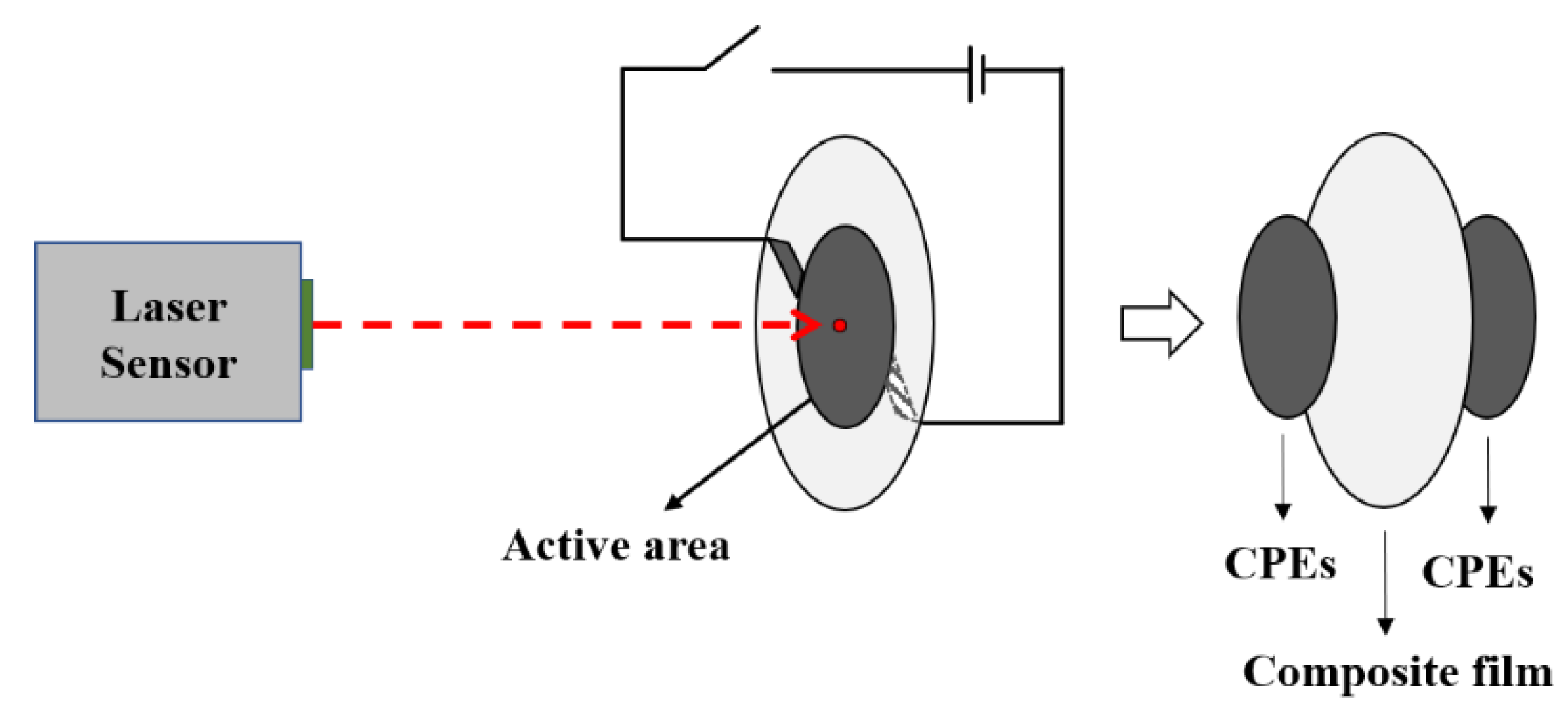
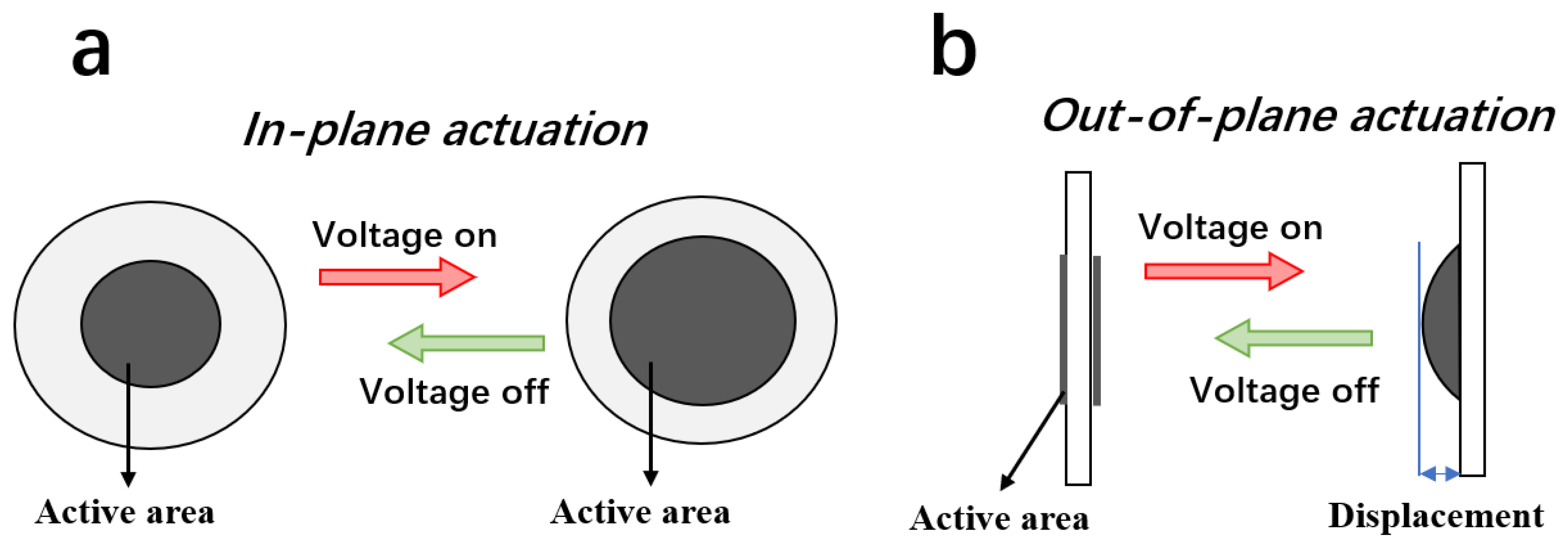
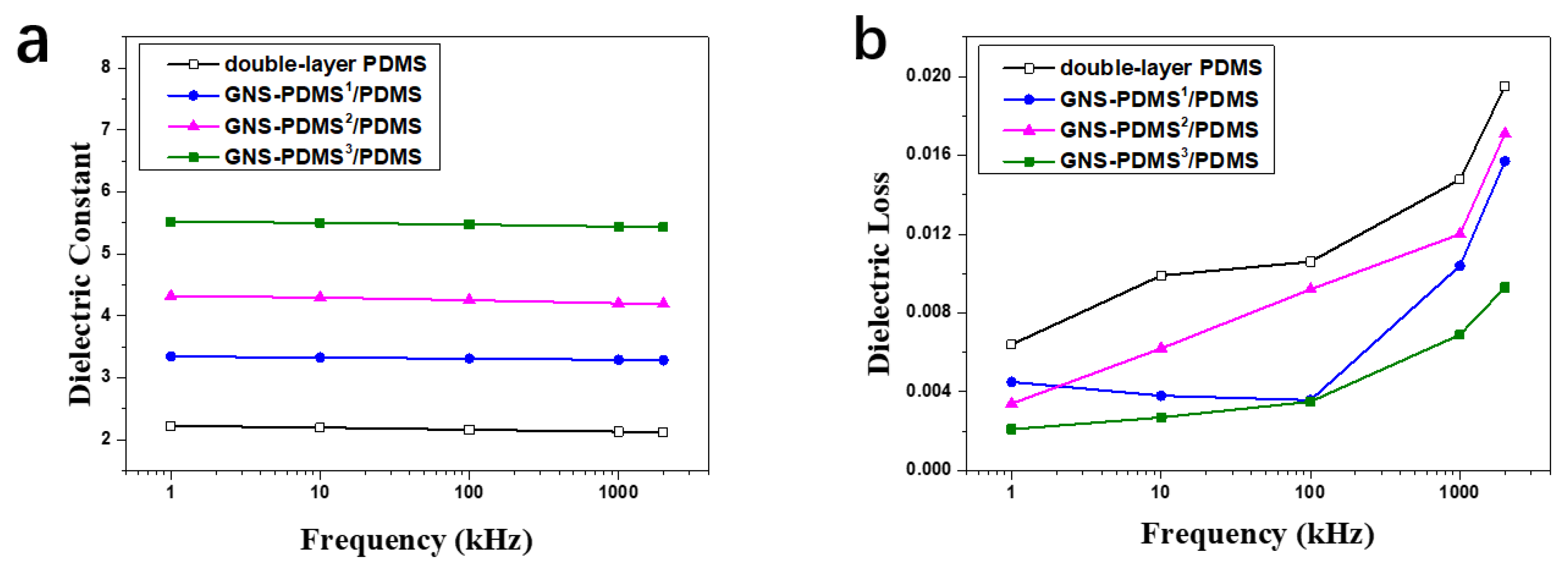
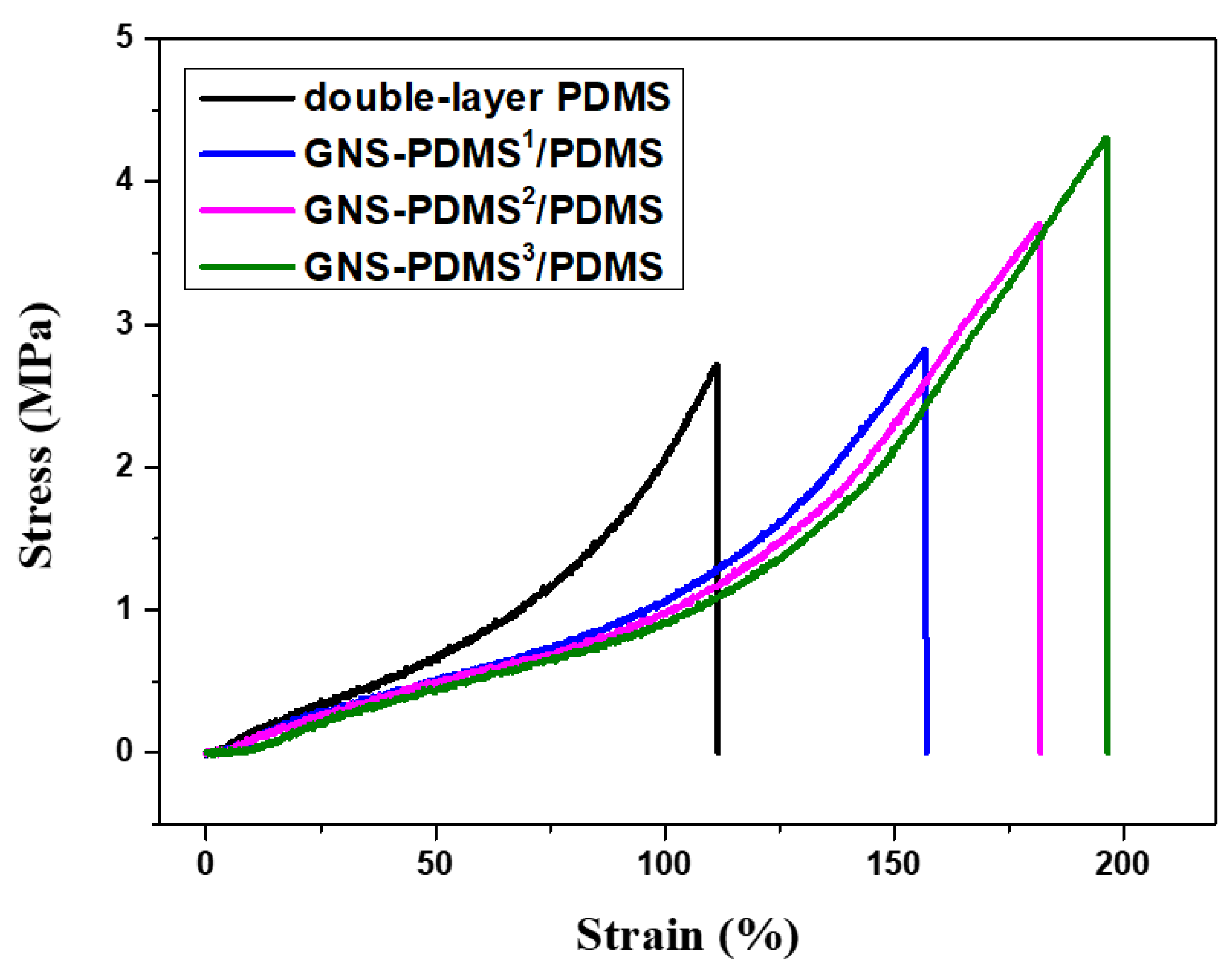
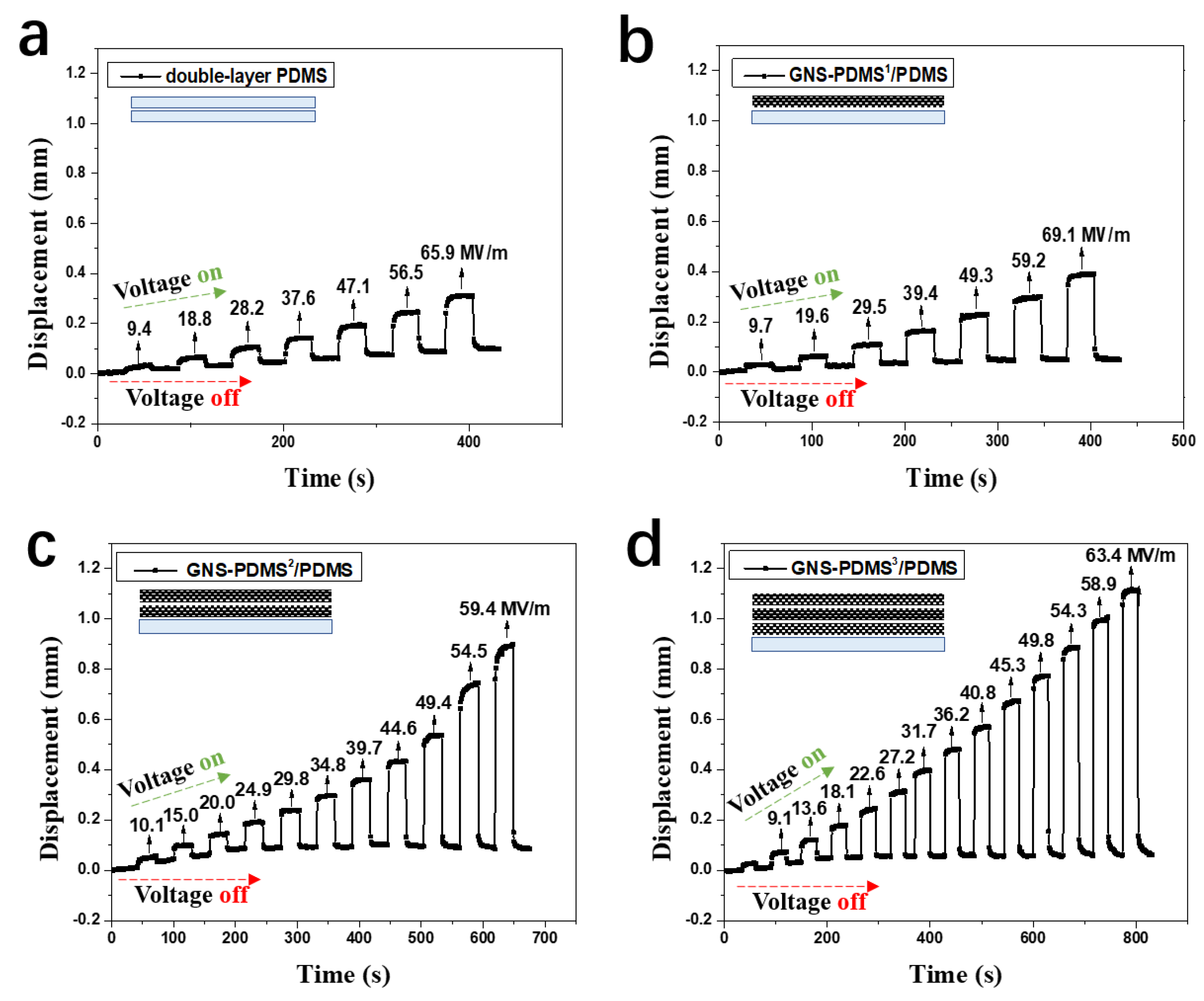
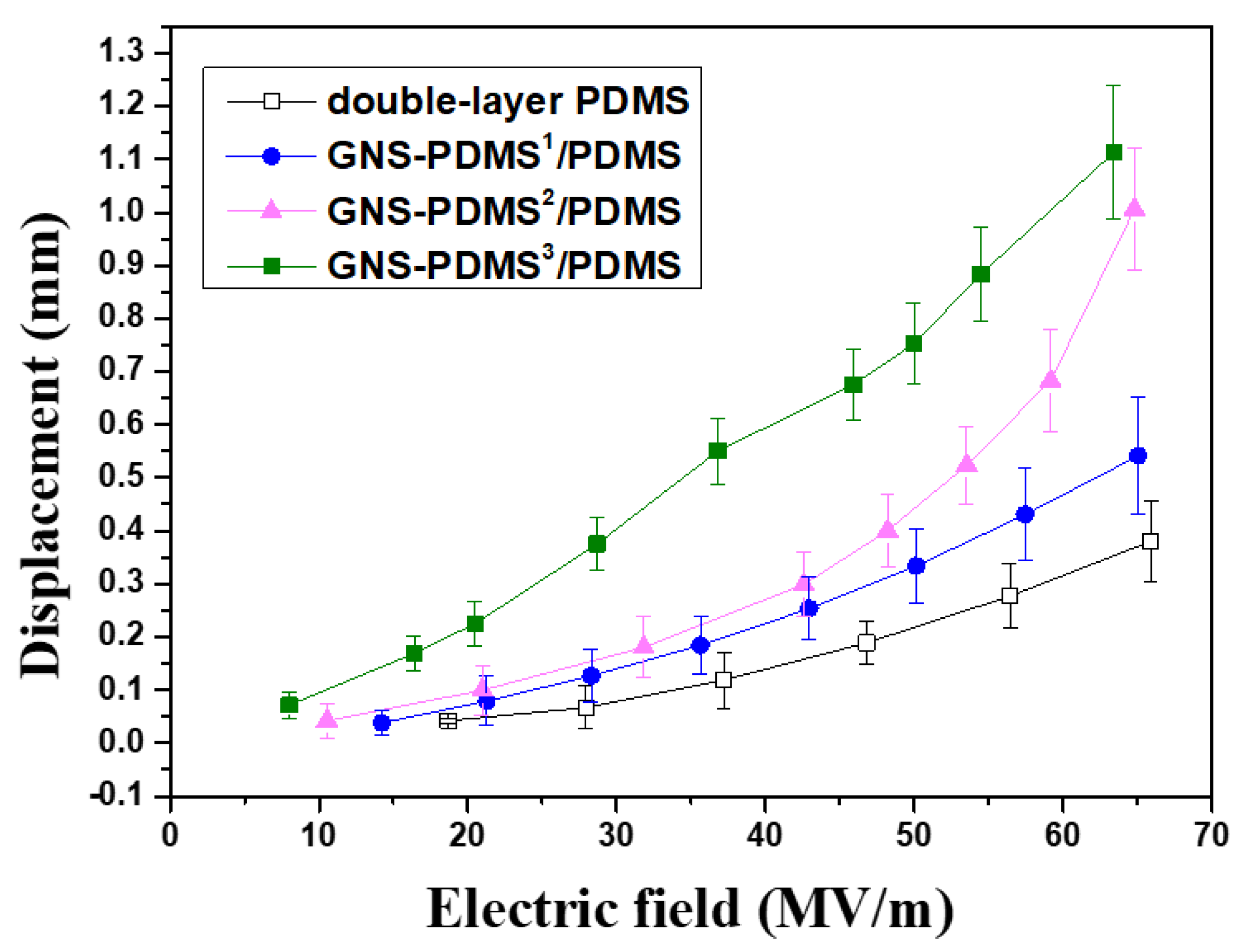
| Sample | Thickness (μm) | Dielectric Constant (at 1 kHz) | Dielectric Loss (at 1 kHz) | Breakdown Field Strength (MV/m) |
|---|---|---|---|---|
| Double-layer PDMS | 78.2 ± 1.5 | 2.22 | 0.0064 | >164 |
| GNS-PDMS1/PDMS | 71.4 ± 1.2 | 3.34 | 0.0045 | 118 ± 2 |
| GNS-PDMS2/PDMS | 96.4 ± 1.3 | 4.32 | 0.0034 | 87 ± 1 |
| GNS-PDMS3/PDMS | 111.6 ± 1.0 | 5.52 | 0.0021 | 64 ± 1 |
| Sample | Tensile Strength at 100% Strain (MPa) | Tensile Strength at Break (MPa) | Young’s Modulus (kPa) | Elongation at Break (%) |
|---|---|---|---|---|
| Double-layer PDMS | 2.07 | 2.72 | 14.6 | 111.3 |
| GNS-PDMS1/PDMS | 1.07 | 2.82 | 11.2 | 156.8 |
| GNS-PDMS2/PDMS | 0.97 | 3.71 | 8.9 | 181.7 |
| GNS-PDMS3/PDMS | 0.91 | 4.30 | 8.6 | 196.3 |
© 2018 by the authors. Licensee MDPI, Basel, Switzerland. This article is an open access article distributed under the terms and conditions of the Creative Commons Attribution (CC BY) license (http://creativecommons.org/licenses/by/4.0/).
Share and Cite
Zhang, C.; Zhai, T.; Zhan, C.; Fu, Q.; Ma, C. Actuation Behavior of Multilayer Graphene Nanosheets/Polydimethylsiloxane Composite Films. Polymers 2018, 10, 1243. https://doi.org/10.3390/polym10111243
Zhang C, Zhai T, Zhan C, Fu Q, Ma C. Actuation Behavior of Multilayer Graphene Nanosheets/Polydimethylsiloxane Composite Films. Polymers. 2018; 10(11):1243. https://doi.org/10.3390/polym10111243
Chicago/Turabian StyleZhang, Chunmei, Tianliang Zhai, Chao Zhan, Qiuping Fu, and Chao Ma. 2018. "Actuation Behavior of Multilayer Graphene Nanosheets/Polydimethylsiloxane Composite Films" Polymers 10, no. 11: 1243. https://doi.org/10.3390/polym10111243
APA StyleZhang, C., Zhai, T., Zhan, C., Fu, Q., & Ma, C. (2018). Actuation Behavior of Multilayer Graphene Nanosheets/Polydimethylsiloxane Composite Films. Polymers, 10(11), 1243. https://doi.org/10.3390/polym10111243






